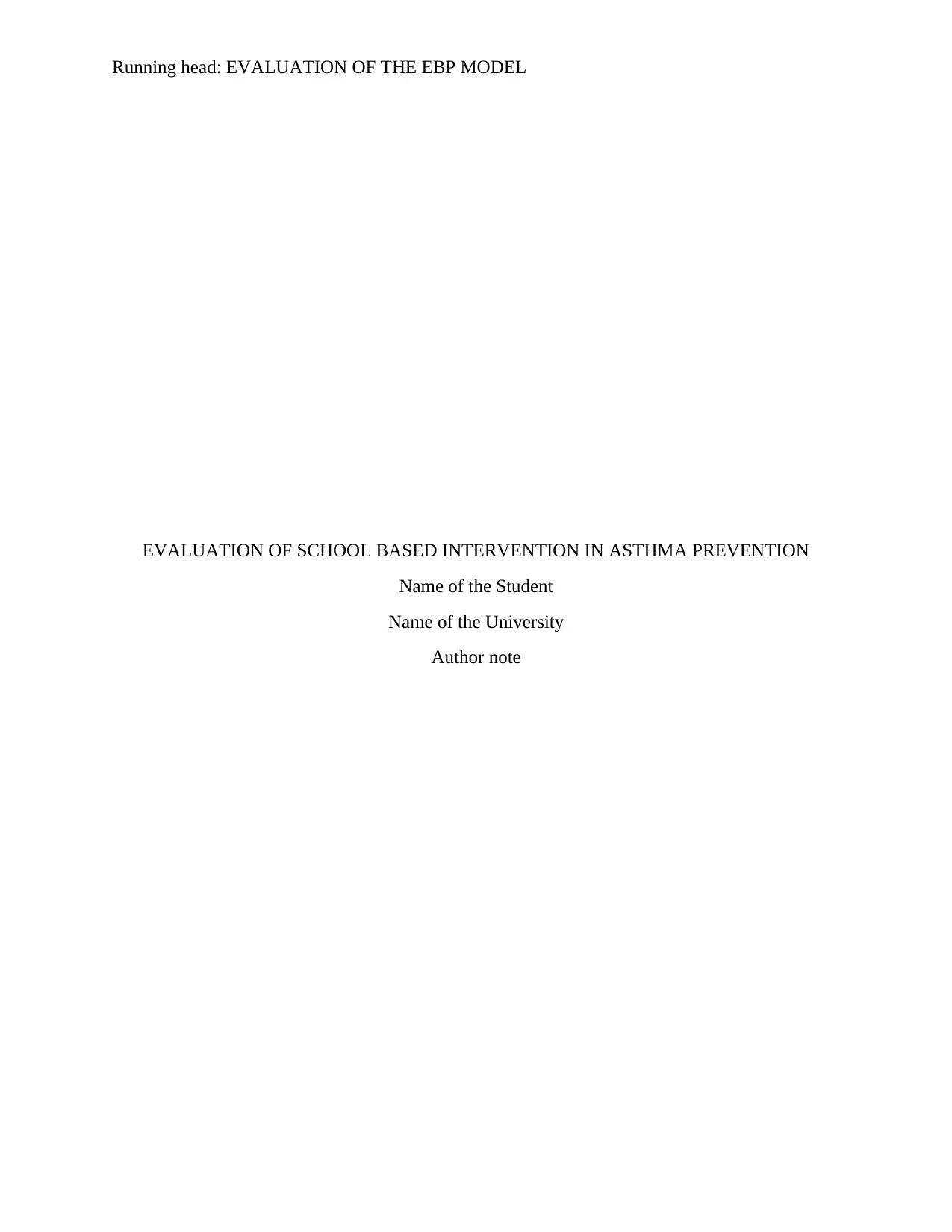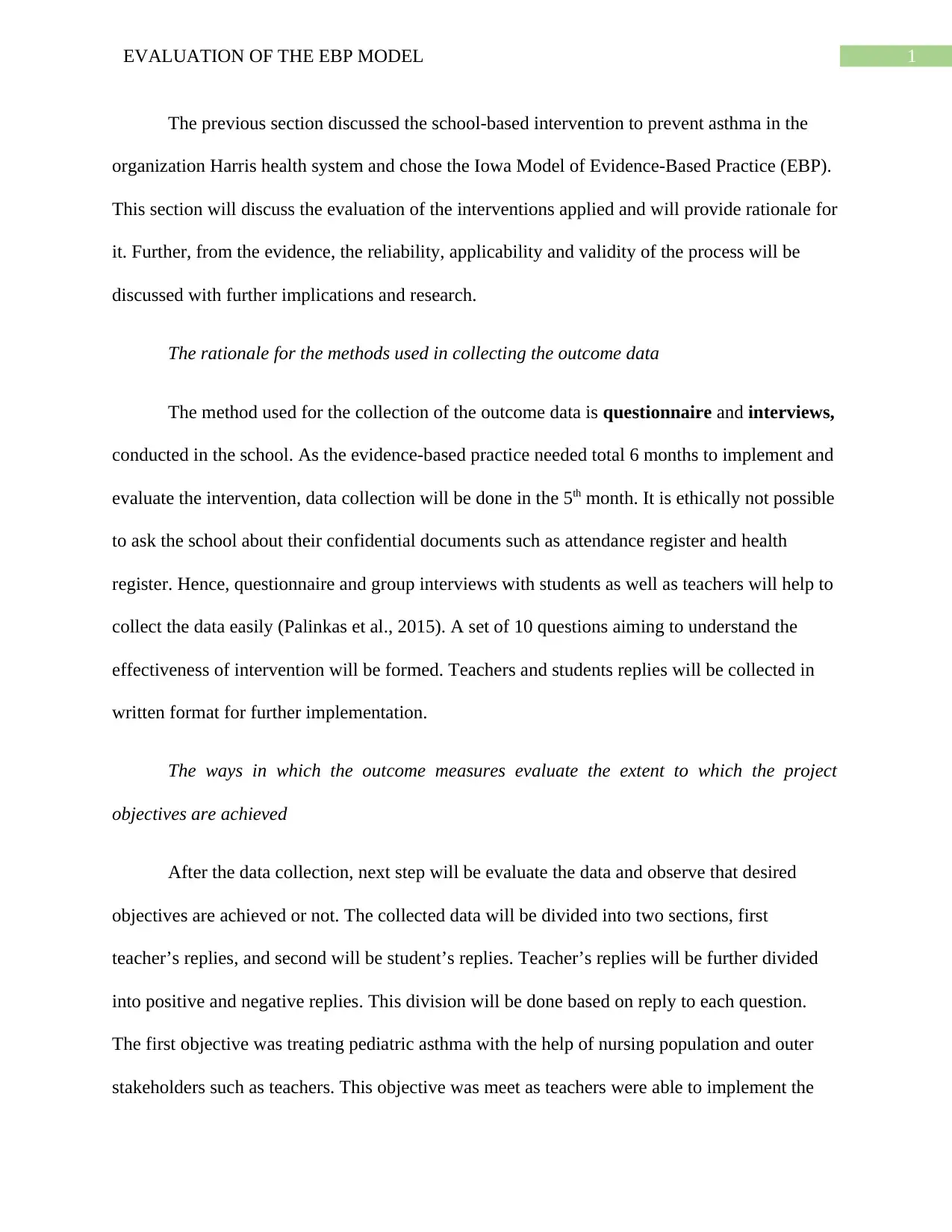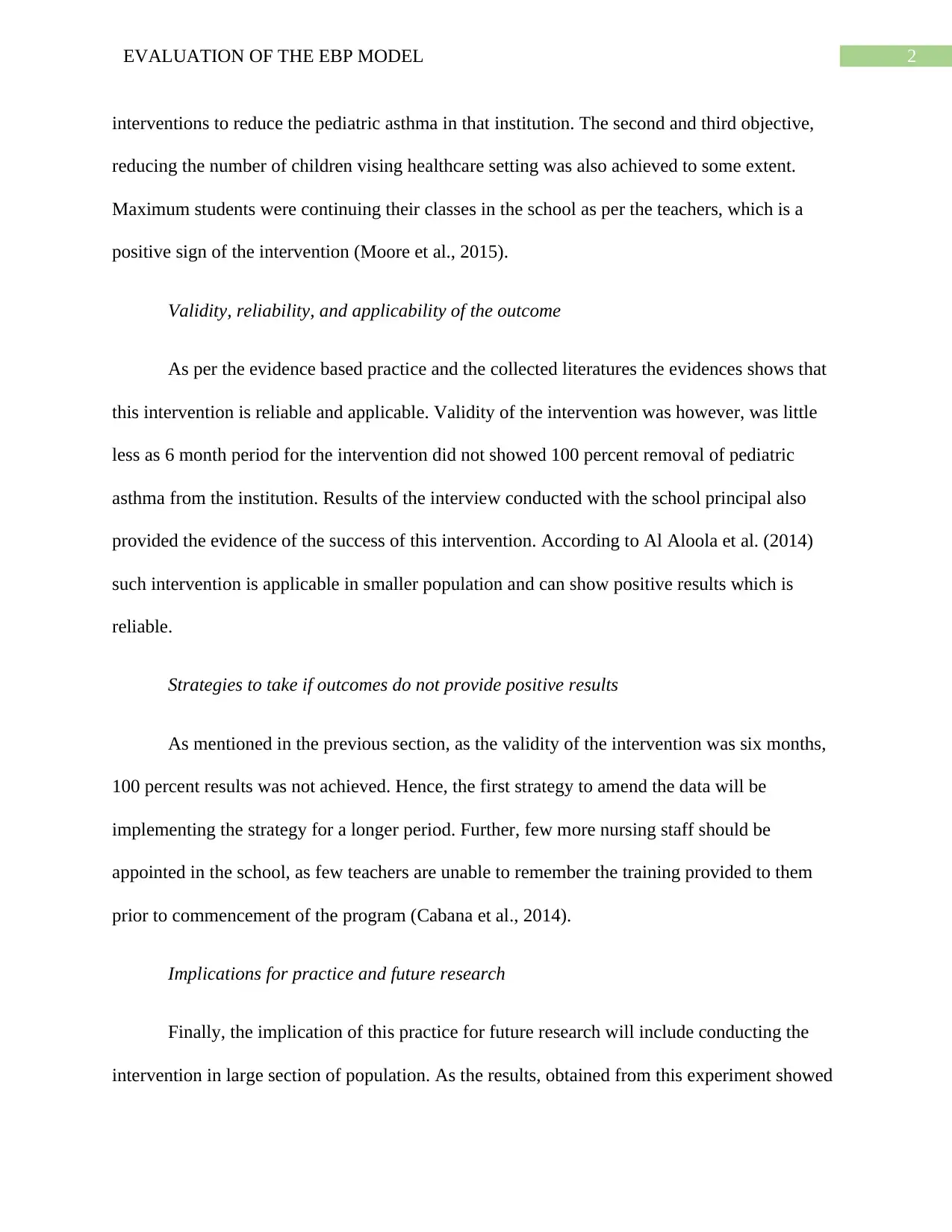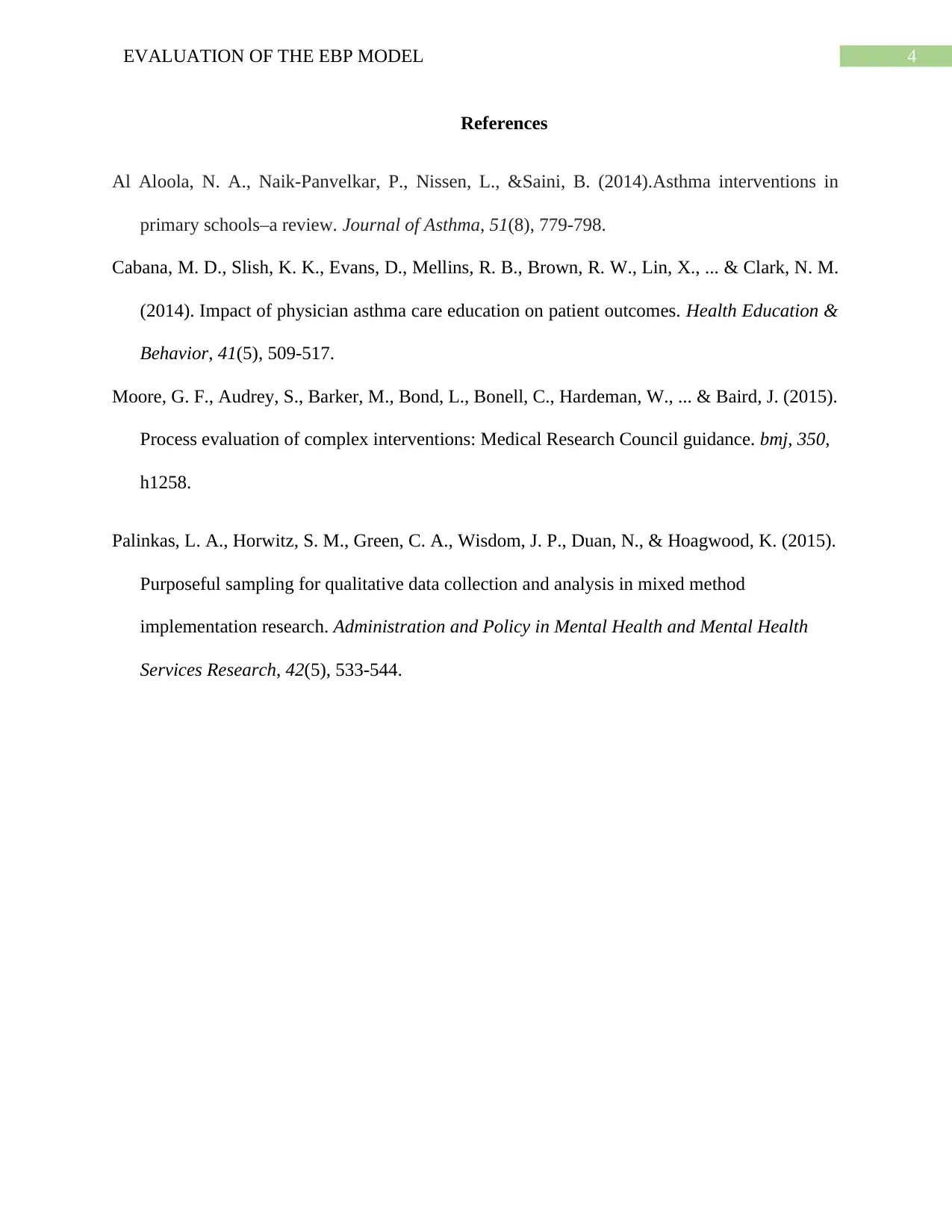Report: Evaluating School-Based Asthma Intervention EBP Model
VerifiedAdded on 2020/04/13
|5
|917
|194
Report
AI Summary
This report evaluates a school-based intervention for asthma prevention, utilizing the Iowa Model of Evidence-Based Practice (EBP). The study employed questionnaires and interviews with students and teachers to assess the intervention's effectiveness over a six-month period. The evaluation focuses on the reliability, applicability, and validity of the intervention, considering its impact on reducing healthcare visits and improving student attendance. The results indicate that the intervention showed positive signs, but the validity was limited due to the short implementation period. Strategies for improvement, such as extending the intervention duration and increasing nursing staff, are suggested. The report concludes with implications for practice, emphasizing the potential for future research involving larger populations to further validate and refine the intervention's efficacy in managing pediatric asthma.

Running head: EVALUATION OF THE EBP MODEL
EVALUATION OF SCHOOL BASED INTERVENTION IN ASTHMA PREVENTION
Name of the Student
Name of the University
Author note
EVALUATION OF SCHOOL BASED INTERVENTION IN ASTHMA PREVENTION
Name of the Student
Name of the University
Author note
Paraphrase This Document
Need a fresh take? Get an instant paraphrase of this document with our AI Paraphraser

1EVALUATION OF THE EBP MODEL
The previous section discussed the school-based intervention to prevent asthma in the
organization Harris health system and chose the Iowa Model of Evidence-Based Practice (EBP).
This section will discuss the evaluation of the interventions applied and will provide rationale for
it. Further, from the evidence, the reliability, applicability and validity of the process will be
discussed with further implications and research.
The rationale for the methods used in collecting the outcome data
The method used for the collection of the outcome data is questionnaire and interviews,
conducted in the school. As the evidence-based practice needed total 6 months to implement and
evaluate the intervention, data collection will be done in the 5th month. It is ethically not possible
to ask the school about their confidential documents such as attendance register and health
register. Hence, questionnaire and group interviews with students as well as teachers will help to
collect the data easily (Palinkas et al., 2015). A set of 10 questions aiming to understand the
effectiveness of intervention will be formed. Teachers and students replies will be collected in
written format for further implementation.
The ways in which the outcome measures evaluate the extent to which the project
objectives are achieved
After the data collection, next step will be evaluate the data and observe that desired
objectives are achieved or not. The collected data will be divided into two sections, first
teacher’s replies, and second will be student’s replies. Teacher’s replies will be further divided
into positive and negative replies. This division will be done based on reply to each question.
The first objective was treating pediatric asthma with the help of nursing population and outer
stakeholders such as teachers. This objective was meet as teachers were able to implement the
The previous section discussed the school-based intervention to prevent asthma in the
organization Harris health system and chose the Iowa Model of Evidence-Based Practice (EBP).
This section will discuss the evaluation of the interventions applied and will provide rationale for
it. Further, from the evidence, the reliability, applicability and validity of the process will be
discussed with further implications and research.
The rationale for the methods used in collecting the outcome data
The method used for the collection of the outcome data is questionnaire and interviews,
conducted in the school. As the evidence-based practice needed total 6 months to implement and
evaluate the intervention, data collection will be done in the 5th month. It is ethically not possible
to ask the school about their confidential documents such as attendance register and health
register. Hence, questionnaire and group interviews with students as well as teachers will help to
collect the data easily (Palinkas et al., 2015). A set of 10 questions aiming to understand the
effectiveness of intervention will be formed. Teachers and students replies will be collected in
written format for further implementation.
The ways in which the outcome measures evaluate the extent to which the project
objectives are achieved
After the data collection, next step will be evaluate the data and observe that desired
objectives are achieved or not. The collected data will be divided into two sections, first
teacher’s replies, and second will be student’s replies. Teacher’s replies will be further divided
into positive and negative replies. This division will be done based on reply to each question.
The first objective was treating pediatric asthma with the help of nursing population and outer
stakeholders such as teachers. This objective was meet as teachers were able to implement the

2EVALUATION OF THE EBP MODEL
interventions to reduce the pediatric asthma in that institution. The second and third objective,
reducing the number of children vising healthcare setting was also achieved to some extent.
Maximum students were continuing their classes in the school as per the teachers, which is a
positive sign of the intervention (Moore et al., 2015).
Validity, reliability, and applicability of the outcome
As per the evidence based practice and the collected literatures the evidences shows that
this intervention is reliable and applicable. Validity of the intervention was however, was little
less as 6 month period for the intervention did not showed 100 percent removal of pediatric
asthma from the institution. Results of the interview conducted with the school principal also
provided the evidence of the success of this intervention. According to Al Aloola et al. (2014)
such intervention is applicable in smaller population and can show positive results which is
reliable.
Strategies to take if outcomes do not provide positive results
As mentioned in the previous section, as the validity of the intervention was six months,
100 percent results was not achieved. Hence, the first strategy to amend the data will be
implementing the strategy for a longer period. Further, few more nursing staff should be
appointed in the school, as few teachers are unable to remember the training provided to them
prior to commencement of the program (Cabana et al., 2014).
Implications for practice and future research
Finally, the implication of this practice for future research will include conducting the
intervention in large section of population. As the results, obtained from this experiment showed
interventions to reduce the pediatric asthma in that institution. The second and third objective,
reducing the number of children vising healthcare setting was also achieved to some extent.
Maximum students were continuing their classes in the school as per the teachers, which is a
positive sign of the intervention (Moore et al., 2015).
Validity, reliability, and applicability of the outcome
As per the evidence based practice and the collected literatures the evidences shows that
this intervention is reliable and applicable. Validity of the intervention was however, was little
less as 6 month period for the intervention did not showed 100 percent removal of pediatric
asthma from the institution. Results of the interview conducted with the school principal also
provided the evidence of the success of this intervention. According to Al Aloola et al. (2014)
such intervention is applicable in smaller population and can show positive results which is
reliable.
Strategies to take if outcomes do not provide positive results
As mentioned in the previous section, as the validity of the intervention was six months,
100 percent results was not achieved. Hence, the first strategy to amend the data will be
implementing the strategy for a longer period. Further, few more nursing staff should be
appointed in the school, as few teachers are unable to remember the training provided to them
prior to commencement of the program (Cabana et al., 2014).
Implications for practice and future research
Finally, the implication of this practice for future research will include conducting the
intervention in large section of population. As the results, obtained from this experiment showed
⊘ This is a preview!⊘
Do you want full access?
Subscribe today to unlock all pages.

Trusted by 1+ million students worldwide

3EVALUATION OF THE EBP MODEL
positive signs and number of students vising healthcare settings decreased, application of this
intervention to a large section of population shows positive signs. Hence, future research of this
intervention is necessary to benefit a larger section of population.
positive signs and number of students vising healthcare settings decreased, application of this
intervention to a large section of population shows positive signs. Hence, future research of this
intervention is necessary to benefit a larger section of population.
Paraphrase This Document
Need a fresh take? Get an instant paraphrase of this document with our AI Paraphraser

4EVALUATION OF THE EBP MODEL
References
Al Aloola, N. A., Naik-Panvelkar, P., Nissen, L., &Saini, B. (2014).Asthma interventions in
primary schools–a review. Journal of Asthma, 51(8), 779-798.
Cabana, M. D., Slish, K. K., Evans, D., Mellins, R. B., Brown, R. W., Lin, X., ... & Clark, N. M.
(2014). Impact of physician asthma care education on patient outcomes. Health Education &
Behavior, 41(5), 509-517.
Moore, G. F., Audrey, S., Barker, M., Bond, L., Bonell, C., Hardeman, W., ... & Baird, J. (2015).
Process evaluation of complex interventions: Medical Research Council guidance. bmj, 350,
h1258.
Palinkas, L. A., Horwitz, S. M., Green, C. A., Wisdom, J. P., Duan, N., & Hoagwood, K. (2015).
Purposeful sampling for qualitative data collection and analysis in mixed method
implementation research. Administration and Policy in Mental Health and Mental Health
Services Research, 42(5), 533-544.
References
Al Aloola, N. A., Naik-Panvelkar, P., Nissen, L., &Saini, B. (2014).Asthma interventions in
primary schools–a review. Journal of Asthma, 51(8), 779-798.
Cabana, M. D., Slish, K. K., Evans, D., Mellins, R. B., Brown, R. W., Lin, X., ... & Clark, N. M.
(2014). Impact of physician asthma care education on patient outcomes. Health Education &
Behavior, 41(5), 509-517.
Moore, G. F., Audrey, S., Barker, M., Bond, L., Bonell, C., Hardeman, W., ... & Baird, J. (2015).
Process evaluation of complex interventions: Medical Research Council guidance. bmj, 350,
h1258.
Palinkas, L. A., Horwitz, S. M., Green, C. A., Wisdom, J. P., Duan, N., & Hoagwood, K. (2015).
Purposeful sampling for qualitative data collection and analysis in mixed method
implementation research. Administration and Policy in Mental Health and Mental Health
Services Research, 42(5), 533-544.
1 out of 5
Related Documents
Your All-in-One AI-Powered Toolkit for Academic Success.
+13062052269
info@desklib.com
Available 24*7 on WhatsApp / Email
![[object Object]](/_next/static/media/star-bottom.7253800d.svg)
Unlock your academic potential
Copyright © 2020–2025 A2Z Services. All Rights Reserved. Developed and managed by ZUCOL.





